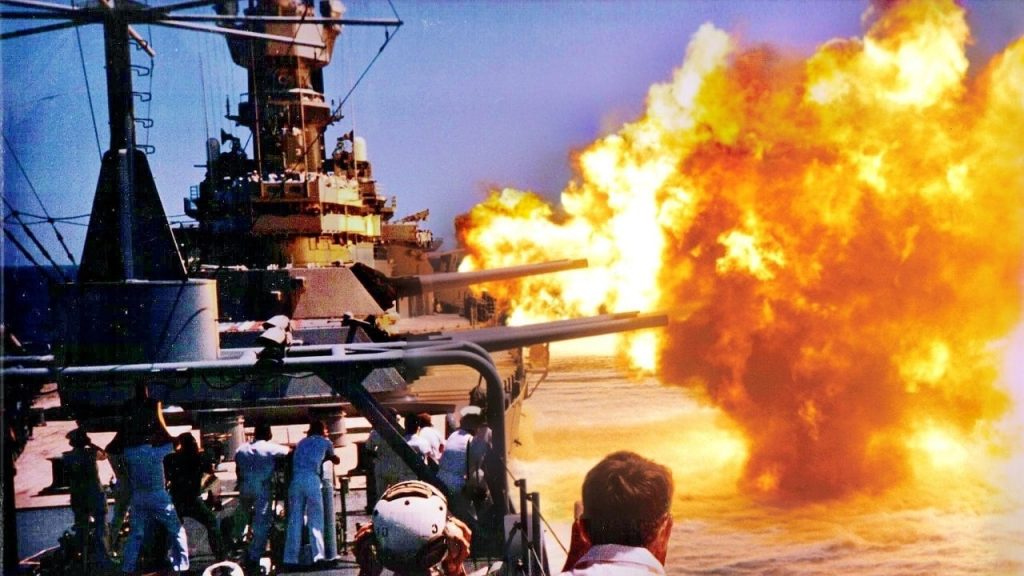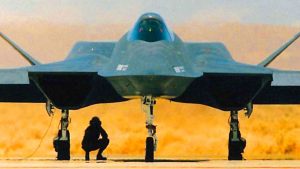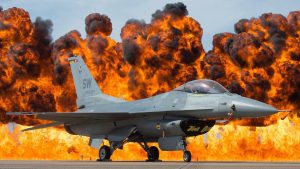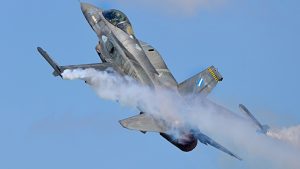Two aircraft carriers and five battleships were part of the Bikini Atoll Nuclear Target Fleet.

Image of US Navy battleship firing. Image Credit: Creative Commons.
“The Royal Navy of the United Kingdom was the most powerful naval force in the world at the start of World War II. At the war’s end, however, the United States Navy had surpassed the Royal Navy in strength, fighting on two fronts simultaneously. Although the U.S. Navy ultimately proved up to the task, and the country was able to crank out a staggering number of warships, it is important to recall that the service already posed a serious threat at the outset of hostilities.
There were 15 battleships, five aircraft carriers, 18 heavy cruisers, and 19 light cruisers in the U.S. Navy in 1939. By the time the United States began the war in late 1941, their figures had ballooned dramatically. Sixteen huge flattops and scores of smaller carriers were constructed even though a new generation of battleships, the Iowa class, entered service.
In 1945, when World War II finally concluded, the United States had more battleships than any other country. Many older battleships served as targets for a whole different type of weapon.
On July 16, 1945, the United States military conducted the first atomic bomb test on the plains of the Alamogordo Bombing Range, also known as the Jornada del Muerto, which is 210 miles south of Los Alamos, New Mexico. Trinity was the secret code name for the experiment.
Exactly one year after the bombing of Japan in August 1945, a joint U.S. Army and Navy task force carried out the first atomic explosions. Operation Crossroads was a nuclear weapons test carried out on the coral reef of Bikini Atoll in the Marshall Islands to learn more about the destructive potential of atomic bombs on military vessels.
A fleet of 95 target ships was prepared at the Bikini Lagoon and detonated two “Fat Man” plutonium implosion-type nuclear weapons over the flotilla. These were the identical bombs that they dropped on Nagasaki. Each of them produced 23 kilotons of TNT.
The first test was called “Able,” and the device was named “Gilda,” after Rita Hayworth’s role in the 1946 film of the same name. A height of 158 metres (520 feet) separated Gilda’s explosion from the targeted fleet. It produced substantially less damage than anticipated since it overshot its target by 2,130 feet (649 metres).
The second test, which occurred on July 25 of that year and was codenamed “Baker,” was accompanied by a bomb with the more colourful codename “Helen of Bikini.” Underwater detonation at 27 metres (90 feet) exposed surrounding test ships to radioactive sea spray.
The Joint Chiefs of Staff Evaluation Board said it was a critical and unanticipated issue. The ships “became radioactive furnace that would have killed everything on board without causing any pain or suffering fatal radiation” after being “infected” by the radioactive lagoon water. Those on the task force tasked with the salvage operations also had to deal with the fallout of the pollution. Plans to clean the ships at the location were put on hold after numerous service members and civilians were exposed to radioactive materials.
Due to the Navy’s inability to disinfect the target ships following the “Baker” test, they scrapped a third deep-water test codenamed “Charlie,” slated for the summer of 1947.
Two aircraft carriers and five battleships were part of the Bikini Atoll Nuclear Target Fleet. The light aircraft carrier USS Independence (CVL-22) and the Lexington-class aircraft carrier USS Saratoga (CV-32), which survived the first test but was severely damaged in the second, were among the ships able to withstand the explosions. Her radioactive hulk was eventually sunk off the coast of San Francisco, California, after being tested at Pearl Harbor and in the city.
The USS Arkansas (BB-33), a Wyoming-class dreadnought battleship, was sunk by the first test, and the Japanese battleship HIJMS Nagato was severely damaged in the bombing on July 25 and sank five days later.
The USS Nevada (BB-36), the flagship of her World War I battleship class and a Pearl Harbor survivor, had also passed both tests and was brought back to the naval base for further inspection. An airborne torpedo eventually sank her after being employed as a gunnery target. Similarly, the lead ship of her class, USS New York (BB-34), and the super-dreadnought battleship, USS Pennsylvania (BB-38), survived the tests and were used for structural testing before being sunk.
Many cruisers, including the German Navy’s Prinz Eugen and a destroyer, were used in the tests, but none were successfully sunk. Obviously, the atomic bomb could completely destroy a city, but it would be far more difficult to sink a warship. Radiation would have killed the crew, but contamination was still a major worry.
Research conducted in 2016 revealed that radiation levels in some areas of Bikini Atoll are still almost six times the maximum acceptable limit, even after all these years since nuclear testing ceased.






